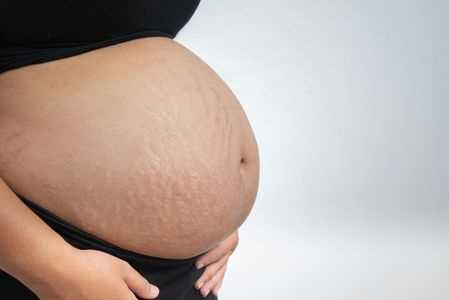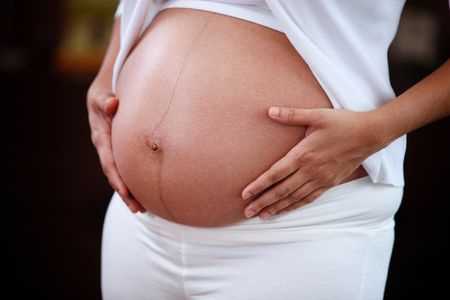The belly of a pregnant woman changes day by day, as does the growing baby inside. Let’s not stop at the physical aspect, the belly doesn’t just get bigger! It evolves, it allows you to feel things, it relaxes … If you all want to know about the belly of a pregnant woman, we tell you everything!
Ah pregnancy! A wave of new sensations and the start of a whole new life. When you are pregnant, a lot of things change. Emotions, moods, tastes, the ban on eating raw milk cheese and drinking a cold beer (terrible)… But what changes above all is the body! More particularly the belly. A pregnant woman will see her belly evolve throughout the pregnancy and over the trimesters. But do you really know the nature of all these changes?
The belly does not stop growing and gaining in volume. There are internal changes, the appearance of stretch marks, the white line, changes in weight … In short, the fetus takes up space and must settle in your uterus. And for that, he needs space! In order to better understand the body of a pregnant woman, we have decided to offer you a small guide on their belly during pregnancy.
Studies of the different weeks of pregnancy, the movements of the belly, the white line, the stretch marks that appear on the skin… We tell you everything! After all, the said belly will still be baby’s home for nine months. You might as well get to know him for real, and not just on the surface!
The first trimester of pregnancy
The first trimester of pregnancy goes from week 1 to week 13. During these first weeks of pregnancy, ie 3 months that you are pregnant, the belly is still very discreet. In general, the pregnant belly does not start to grow until week 10. Sometimes a future mother can even wait until week 19 to see her belly round!
It is during the first trimester that one begins to feel symptoms such as nausea, vomiting, fatigue … Which are quite simply linked to your level of HCG (chorionic gonadotropin hormone, in other words “pregnancy hormone “) which is soaring. It is also during these first weeks that the embryo transforms into a fetus in the womb. This phase, called the fetal period, occurs in the 9th week of pregnancy.
At the end of the third month, we begin to observe small curves in the belly. As for the uterus, it grows upwards. His ligaments are stretching, which is why we may start to feel a little pain and tightness. Therefore, as the uterus moves up towards the abdominal cavity, your bladder is no longer compressed! FINALLY ! It is also during this third month that we begin to see baby in images on the ultrasound.
The second trimester of pregnancy
The second trimester of pregnancy goes from week 14 to week 28. It is after the 6th month that this trimester will end! During this trimester, the very unpleasant symptoms experienced during the first 13 weeks gradually evaporate. The belly of a 14 week pregnant woman is changing more and more. This is usually when pregnant women gain a little weight.. On average, this weight increases from 6 to 8 kg. It is also possible that the waist measurement takes 8 to 10 cm, and this is completely normal! It’s just taking up space, this baby. As for the latter, it forms slowly but surely.
It is during the 5th month that a pregnant woman will discover a whole new sensation: the moving belly! And yes, there it is, baby starts dancing in the womb. This is also when people start to really want to touch your belly. You have the right to say no! It’s YOUR belly, and being pregnant isn’t an invitation for intrusive hands.
At the level of the 5th and 6th month, it is possible to feel small pains in the belly : these are simply carbon dioxide produced by the pregnant woman, but also by the baby. In addition, since the belly becomes rounded day by day, the back is hollow and it is then normal to feel pain in the back. Little anecdote, at the end of the 6th month, the fetus begins to react to sounds!
The third trimester of pregnancy
The third trimester of pregnancy runs from week 27 through week 40. The belly is round and the uterus is preparing for childbirth. This is why during the third trimester, from the 6th to the 9th month, the uterus may contract from time to time, sometimes even several times a day. Pregnant women usually feel heavier during the past few weeks. Not necessarily in terms of weight, but because all the organs, except the liver, have taken on size, and the fetus is getting bigger and bigger.
It is during this trimester that a pregnant woman will be on maternity leave, just to spare herself as much as possible. Yes, it is heavy to carry, this belly! Baby fills all the space of the uterus, it is not nothing. Suddenly, he moves less, but is no less present!
During the 9th month, the fetus begins to descend towards the pelvis, which can obviously cause some pain at this level. Come on, it’s over soon!
Feel baby when you’re pregnant
Not all expectant mothers start to feel their fetus move at the same time during pregnancy. For some pregnant women, it is possible to feel baby moving as early as 3 and a half months of pregnancy. For others, you have to wait around the 5th month. Although the fetus begins to move its arms and legs at the 7th week of amenorrhea, it is most often between the 18th and 21st that a pregnant woman will feel the baby move.
It is most often in the evening that baby is agitated. Indeed, when the expectant mother is lying down to sleep, this is where the fetus is most comfortable, especially if she is on the side. And yes, it can expand! Then, the bigger the baby, the more you will feel it!
The Pregnancy Belly Line
Have you ever noticed this line from the navel to the pubis in pregnant women? This line is a simple pigmentary change due to pregnancy.
© GettyImages-1030577274
In general, we can see its appearance in the third month of pregnancy. This pigmentary change is explained quite simply by the melanocytes of the skin which secrete more melanin during gestation. This secretion will darken the skin and cause spots, pregnancy spots, or moles to appear. The line can also widen over the weeks and the fetus gains in place.
Don’t panic, the line eventually fades after childbirth!
Pregnant woman’s stretch marks
Stretch marks, by their definition, are small streaks that crisscross the skin in places that have been stretched. Since the body and skin of a pregnant woman changes enormously during pregnancy, it is quite normal for them to appear on the breasts, thighs, hips and stomach. Stretch marks are actually due to a loss of elasticity in the skin. After being stretched for a long time, the muscle fibers of the skin will crack and therefore form small traces. Indeed, during pregnancy, hormonal changes and weight gain are responsible for a decrease in the production of collagen and elastin.

© GettyImages-1180187093
Some products to treat stretch marks
In general, stretch marks appear during the 8th and 9th month of pregnancy. Of course, depending on the body, they can appear much earlier.
To see also: 10 questions to know everything about pregnancy stretch marks
After childbirth, stretch marks do not go away. Indeed, their original bluish color will turn into a pearly white. When they take on this color, it means that they are healed. Some, due to their small size, will hardly be seen. However, it is possible to reduce them with moisturizers or nourishing oils. The best is to go see a dermatologist!
We remind you that stretch marks are in no way a shame, and should not be hidden at all costs. We obviously understand that they can form a complex, but it is a completely natural thing, due to pregnancy or weight gain / loss. And all of these things are natural and are a part of life. They are brands, yes, but they are not ugly or disturbing. So if someone makes you a remark about your stretch marks, do not hesitate to repack it!
The belly after childbirth
After childbirth, the belly is voluminous, a little soft, there are stretch marks, the line on the lower abdomen is still there … And this is completely normal. This is because the uterus does not return to its normal shape at the time of childbirth. What is called uterine involution can take 5-10 days. In addition, a woman who has just given birth may suffer from lochia: small postpartum bleeding, which can last from 10 days to 6 weeks. Do not panic ! These blood losses are due to hormonal changes and decreased blood volume, and are largely involved in a bulky belly.
As for stretch marks, they are more difficult to remove. They must be well hydrated. The lower abdomen line will go away on its own!
If you want to regain your pre-pregnancy belly, you just need to arm yourself with patience and tolerance. The body has undergone major upheavals during pregnancy and needs to recover slowly.
Discover our Newsletters!
We have so much to tell you: news, trends and all kinds of exclusions.
I subscribe
